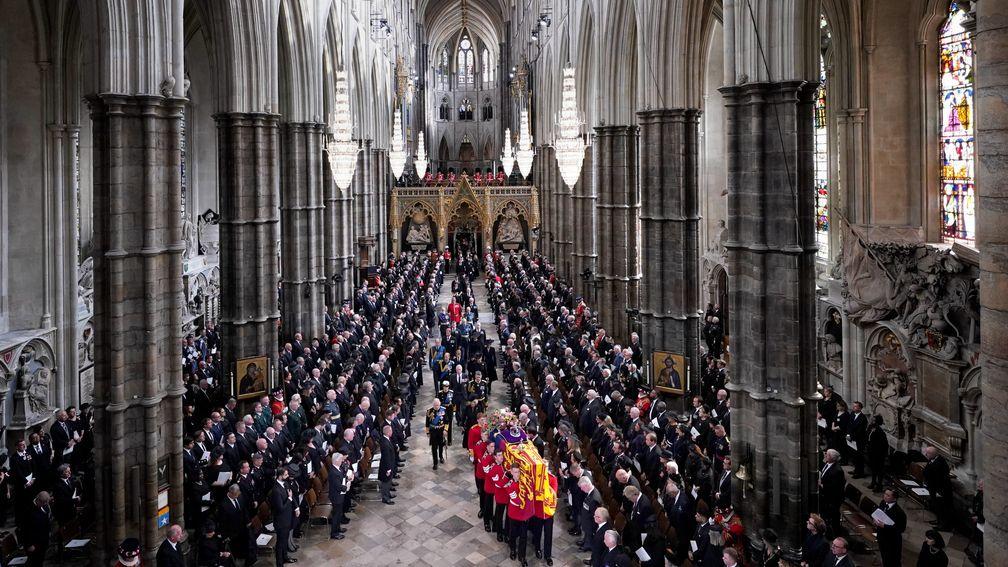A day of sorrow and ceremony: state funeral marks the Queen's final journey

The state funeral of Queen Elizabeth II took place on a day full of symbolism, ceremony and sorrow.
And alongside more than 100 heads of state among a total of 500 international dignitaries, the Queen’s connection to the world of horseracing was well represented, as thousands of mourners lined the streets of the capital to witness the procession of Her Late Majesty's coffin, followed by King Charles and other leading members of the royal family.
The Queen’s racing adviser John Warren, trainer Gai Waterhouse and Jockey Club senior steward Sandy Dudgeon were among the congregation of 2,000 inside the abbey.
Trainers Richard Hannon and Andrew Balding then joined Warren and many European monarchs in travelling to Windsor for the committal service at St George's Chapel, which was also attended by wider members of the Queen's family and members of the royal household.
Fellow royal trainers Sir Michael Stoute, Michael Bell, William Haggas and Roger Charlton also attended the more intimate service in Windsor along with Sue Magnier and her daughter Kate Wachman.

On a day when even presidents and emperors were mere witnesses to the historic scenes played out in London and Windsor, it was nonetheless noteworthy that what the Queen Consort had referred to in a televised address as the Queen's "private passion" of horseracing was so heavily represented.
"We were three rows back facing the procession so we were able to see everybody and everything that was happening," said Dudgeon of the service in Westminster Abbey. "It was a hugely humbling place to be.
"The hymns and music were magnificent but the silences made you think. It made me think that we were very fortunate and proud to have Her Majesty Queen Elizabeth II as our patron.
"Her passion for horseracing was not mentioned in the abbey but millions of people saw that passion all around the world."
Dudgeon, who also met the Queen on a number of occasions in connection with his role as High Constable and Guard of Honour of Holyrood House, added: "The sport remains part of the fabric of our lives – and it is because of that sport I was lucky enough to be asked to attend the funeral."

Pulled by massed ranks of Royal Navy ratings, the gun carriage bearing the Queen's coffin was accompanied on the short trip from Westminster Hall to the abbey by the Massed Pipes and Drums of the Scottish and Irish Regiments.
The Dean of Westminster, Dr David Hoyle, opened the service with a call to "recall her love for her family and her commitment to the causes she held dear".
Following readings given by the secretary general of the Commonwealth Baroness Scotland and the prime minister Liz Truss, the Archbishop of Canterbury Justin Welby delivered the sermon in which he highlighted a speech made by Queen Elizabeth on her 21st birthday in which she swore devotion to serve for her whole life, "whether it be long or short".
The archbishop said: "Rarely has such a promise been so well kept. Few leaders have received the outpouring of love which we have seen."

After an hour-long service which featured a wide variety of choral music and hymns, five buglers sounded The Last Post and, following two minutes' silence, the sovereign's piper played a traditional lament, Sleep Dearie Sleep.
Many of the congregation bowed their heads as the eight bearers carried the Queen's coffin back through the abbey and out to the waiting gun carriage.
Once again the Queen's four children formed an honour guard as the funeral procession made the journey past Buckingham Palace on its way to Wellington Arch, the crown and the royal standard shrouding the coffin standing out among the soldiers, sailors and air personnel.
After driving to Windsor the royal hearse joined up with a new procession. Here the equine heritage of Britain's military was on full display, as the Household Cavalry escorted the late sovereign up the Long Walk to Windsor Castle, passing the staff of the Royal Mews and the Queen's pony, Emma.

The St George's Chapel Own Choir reprised the Russian Contakion of the Departed which had been sung at the Duke of Edinburgh's funeral 17 months earlier.
Addressing the 800-strong congregation, the Dean of Windsor David Conner said of the Queen: "Her calm and dignified presence has given us the courage to face the future with courage and with hope."
After the removal of the crown, orb and sceptre, the Sovereign's piper played again as the Queen's coffin was lowered from sight into the royal vault ahead of a private burial ceremony in the King George VI Memorial Chapel.
In Tuesday's Racing Post

Published on inNews
Last updated
- Join Racing Post Members' Club for the very best in racing journalism - including Patrick Mullins' unmissable trip to see Gordon Elliott
- Racing Post Members' Club: 50% off your first three months
- Join the same team as Ryan Moore, Harry Cobden and other top jockeys with 50% off Racing Post Members' Club
- 'It’s really exciting we can connect Wentworth's story to Stubbs' - last chance to catch master painter's homecoming
- The jumps season is getting into full swing - and now is the perfect time to join Racing Post Members' Club with 50% off
- Join Racing Post Members' Club for the very best in racing journalism - including Patrick Mullins' unmissable trip to see Gordon Elliott
- Racing Post Members' Club: 50% off your first three months
- Join the same team as Ryan Moore, Harry Cobden and other top jockeys with 50% off Racing Post Members' Club
- 'It’s really exciting we can connect Wentworth's story to Stubbs' - last chance to catch master painter's homecoming
- The jumps season is getting into full swing - and now is the perfect time to join Racing Post Members' Club with 50% off